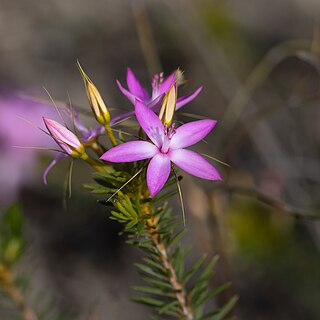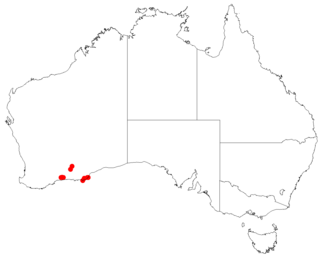
Calytrix depressa is a species of flowering plant in the myrtle family Myrtaceae and is endemic to the south-west of Western Australia. It is a glabrous shrub with linear to lance-shaped leaves and mauve to violet or yellow flowers with 35 to 75 stamens in several rows.

Calytrix aurea is a species of flowering plant in the myrtle family Myrtaceae and is endemic to the south-west of Western Australia. It is a shrub with elliptic, lance-shaped or linear leaves and clusters of yellow flowers with 25 to 55 yellow stamens in several rows.
Calytrix amethystina is a species of flowering plant in the myrtle family Myrtaceae and is endemic to inland areas of Western Australia. It is a glabrous shrub with egg-shaped to oblong or more or less round leaves and clusters of purple to violet flowers with about 35 to 80 white stamens in several rows.

Calytrix achaeta, commonly known as the white-flowered turkey bush, kerosene wood or fringe-myrtle, is a species of flowering plant in the myrtle family Myrtaceae and is endemic to north-western Australia. It is a shrub or tree with hairy branchlets, egg-shaped, linear or lance-shaped leaves, and white to cream-coloured flowers with 12 to 18 stamens in a single row.

Calytrix acutifolia is a species of flowering plant in the myrtle family Myrtaceae and is endemic to south-west of Western Australia. It is a slender, openly-branched shrub with linear to lance-shaped leaves and clusters of white, cream-coloured or yellow flowers with 40 to 85 white stamens in several rows.

Calytrix asperula, commonly known as brush starflower, is a species of flowering plant in the myrtle family Myrtaceae and is endemic to the south of Western Australia. It is a mostly glabrous shrub with linear to narrowly elliptic leaves and cream-coloured to yellow flowers with 40 to 60 yellow stamens in several rows.
Calytrix birdii is a species of flowering plant in the myrtle family Myrtaceae and is endemic to inland areas of Western Australia. It is a shrub with egg-shaped to more or less round leaves and clusters of purple flowers with 45 to 55 reddish-purple stamens in several rows.

Calytrix brevifolia is a species of flowering plant in the myrtle family Myrtaceae and is endemic to the west of Western Australia. It is a glabrous shrub with egg-shaped, linear, elliptic or more or less round leaves and clusters of pink to magenta flowers with about 40 to 90 yellow stamens in 4 rows.
Calytrix breviseta is a species of flowering plant in the myrtle family Myrtaceae and is endemic to the south-west of Western Australia. It is a more or less glabrous shrub with egg-shaped, elliptic, lanceolate, oblong or linear leaves and clusters of purple flowers with about 25 to 65 white stamens in several rows, becoming reddish-purple as they age.

Calytrix brownii, commonly known as the white turkeybush, is a species of plant in the myrtle family Myrtaceae and is endemic to northern Australia. It is an erect or prostrate shrub with linear to narrowly elliptic leaves and white to creamish, star-shaped flowers with about 18 to 25 white stamens in a single row.

Calytrix carinata is a species of flowering plant in the myrtle family Myrtaceae and is endemic to northern Australia. It is a more or less glabrous shrub with egg-shaped, elliptic, linear or lanceolate leaves and clusters of pink, pinkish purple, or reddish flowers with about 30 to 50 pink and yellowish white stamens in two rows.

Calytrix chrysantha is a species of flowering plant in the myrtle family Myrtaceae and is endemic to the south-west of Western Australia. It is a glabrous shrub usually with oblong to linear leaves and clusters of yellow flowers with about 45 to 55 yellow stamens in several rows.

Calytrix decandra, commonly known as pink starflower, is a species of flowering plant in the myrtle family Myrtaceae and is endemic to the south of Western Australia. It is a semi-prostrate, glabrous shrub with linear to narrowly elliptic leaves and pink, mauve or magenta flowers with usually 10 stamens in a single row.

Calytrix desolata is a species of flowering plant in the myrtle family Myrtaceae and is endemic to the western regions of Western Australia. It is a glabrous shrub with linear oblong or lance-shaped leaves with the narrower end towrds the base, and pink to purple flowers with about 30 to 60 stamens in several rows.

Calytrix exstipulata, commonly known as turkey bush, Kimberley heather, heather bush or pink fringe-myrtle, is a species of flowering plant in the myrtle family Myrtaceae and is endemic to northern Australia. It is an erect shrub with narrowly egg-shaped to elliptic leaves and clusters of dark red, pink and white flowers with mainly pink stamens.

Calytrix sapphirina is a species of plant in the myrtle family Myrtaceae that is endemic to Western Australia.
Micromyrtus stenocalyx is a species of flowering plant in the family Myrtaceae and is endemic to the inland of Western Australia. It is a straggly or widely spreading shrub with oblong or club-shaped leaves pressed against the stem, and cream-coloured to yellow flowers with 10 stamens.
Thryptomene elliottii is a species of flowering plant in the family Myrtaceae and is endemic to southern central Australia. It is a shrub with decussate, egg-shaped to club-shaped leaves and pink or white flowers with five petals and five stamens.

Stachystemon polyandrus is a species of flowering plant in the family Picrodendraceae and is endemic to the southwest of Western Australia. It is a diffuse to straggling, monoecious shrub with crowded, oblong, elliptic or egg-shaped leaves with the narrower end towards the base, and small yellowish-white flowers arranged singly in upper leaf axils, but forming clusters at the ends of branches.

Leucopogon bossiaea is a species of flowering plant in the heath family Ericaceae and is endemic to a restricted area in the south-west of Western Australia. It is an erect shrub with elliptic to broadly egg-shaped leaves and white flowers in four to eleven upper leaf axils.
















